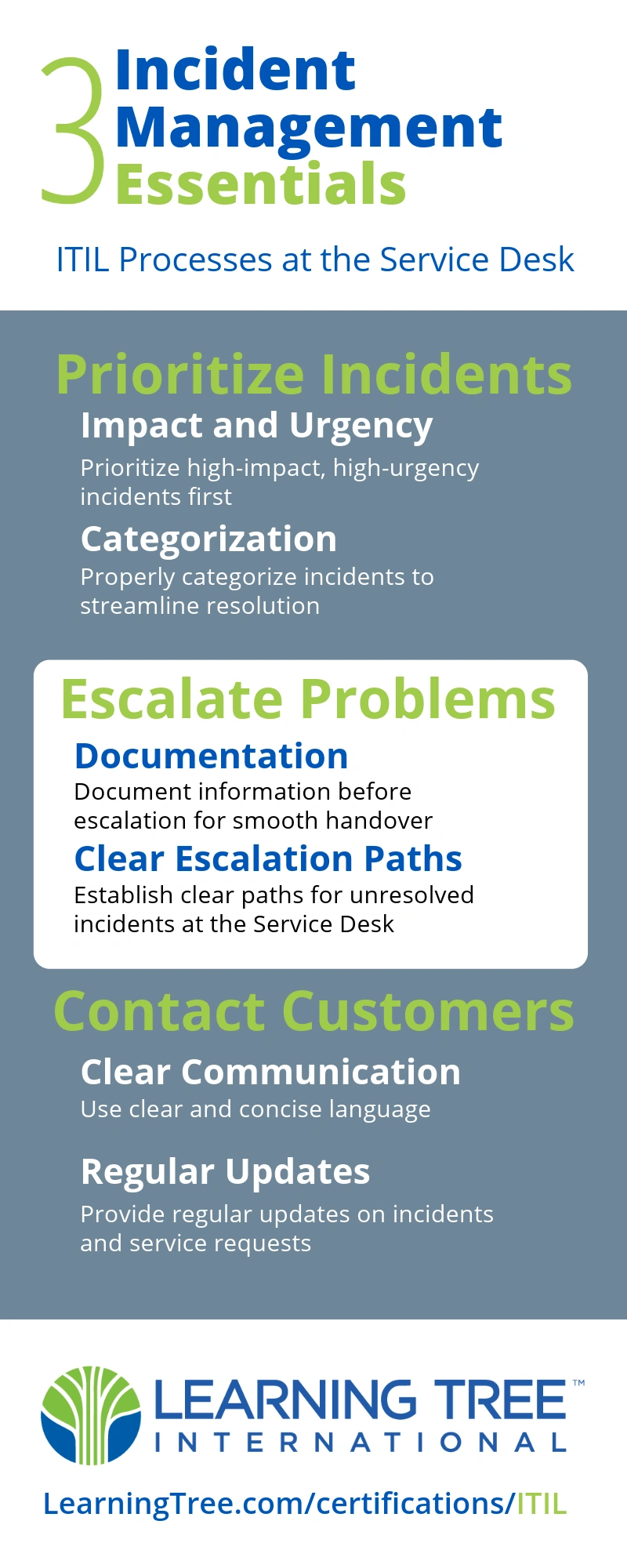This blog will introduce you to ITIL processes and the essential skills for efficient Service Desk operations. We'll delve into crucial components such as Incident Management, Problem Management, Change Management, and Service Level Management. Ultimately, you'll grasp how these methods can enhance your IT offerings, providing superior value to clients and stakeholders.
Introduction to ITIL and ITIL Foundation Skills
What is ITIL?
The Information Technology Infrastructure Library (ITIL) is a way of managing IT services (ITSM) to meet business processes and goals. It helps IT service providers deliver value in a systematic way.

Importance of ITIL Foundation Skills for Service Desk Operations
ITIL Foundation skills are crucial for Service Desk work. They equip staff with knowledge to effectively manage IT services and understand key ITIL components, including concepts, principles, and processes. This understanding enables them to deliver high-quality service and support.
Key Components of ITIL and Their Application in Service Desk Operations
Incident Management
Incident Management aims to restore normal service operations as quickly as possible and minimize the impact on business operations. It requires identifying, logging, categorizing, prioritizing, and resolving incidents. For example, when someone gets locked out of their email, the Service Desk tags the mishap with a red 'urgent' label and resets the password promptly.
Application in Service Desk Operations:
- Logging Incidents: Service Desk agents log all incidents reported by users.
- Categorizing and Prioritizing: Incidents are categorized and prioritized based on their impact and urgency.
- Resolution and Recovery: Service Desk agents work to resolve incidents or escalate them to appropriate teams.
- Closure: Once resolved, incidents are closed, and users are informed.
Problem Management
Problem Management involves identifying and resolving the root causes of incidents to prevent recurrence or reduce their impact. For instance, if the Service Desk notices frequent incidents of an application crashing, they might discover a software bug is responsible. They would then request the development team to address this issue. The team could create a patch to fix the bug, resolving the problem and preventing future incidents.
Application in Service Desk Operations:
- Identifying Problems: Service Desk agents identify recurring incidents that may indicate underlying problems.
- Root Cause Analysis: Conducting root cause analysis to determine the cause of problems.
- Implementing Solutions: Developing and implementing solutions to prevent future incidents.
Change Management
Change Management makes sure that IT service changes are done safely and smoothly. For example, a Service Desk agent asks for permission to update the email server software for better security. To avoid problems, a change to an IT service is checked, approved, and planned for a time when few people are using it.
Application in Service Desk Operations:
- Request for Change (RFC): Service Desk agents submit RFCs for changes needed to resolve incidents or problems.
- Change Evaluation: Evaluating the impact and risk of proposed changes.
- Change Implementation: Coordinating the implementation of changes with minimal disruption to services.
Service Level Management
Service Level Management involves defining, agreeing, and managing service levels to ensure IT services meet business needs. For example, the Service Desk has an SLA that guarantees a response to high-priority incidents within 30 minutes; they monitor response times and generate reports on time to resolution to ensure they meet this commitment.
Application in Service Desk Operations:
- Service Level Agreements (SLAs): Establishing SLAs with customers to define expected service levels.
- Monitoring Performance: Monitoring service performance against SLAs.
- Reporting and Review: Regularly review and report on service performance to ensure compliance with SLAs.
Knowledge Management
In ITIL and Service Desk Operation, Knowledge Management is a process that involves obtaining, assessing, storing, and distributing knowledge developed within an IT service desk. It is designed to help service desk teams make the right decisions throughout the service lifecycle and incident resolution process by efficiently controlling and managing the flow of information.
Application in Service Desk Operations:
In a Service Desk, agents document solutions to common issues, like VPN connection problems, in a Knowledge Base article. This article includes detailed steps, screenshots, and troubleshooting tips. Other agents can quickly refer to it to resolve similar issues efficiently and consistently.
Steps for Effective Knowledge Management:
- Documentation of Resolutions: Agents document known issues and their resolutions into a centralized Knowledge Base.
- Regular Updates: Ensuring the Knowledge Base is regularly updated to reflect changes in procedures or solutions.
- Accessible Information: Making the Knowledge Base easily accessible to all Service Desk agents.
- Review and Feedback: Encouraging agents to review Knowledge Base articles and provide feedback for continuous improvement.
By integrating Knowledge Management practices, Service Desks can enhance efficiency, consistency, and overall service quality, improving customer satisfaction and reducing operational costs.
Blog continues after infographic...

Measuring Service Desk Performance with Metrics
Metrics are essential in measuring Service Desk performance as they provide quantifiable data that helps evaluate service delivery's efficiency and effectiveness. Organizations can identify improvement areas by tracking metrics and ensuring alignment with business objectives.
Metrics enable data-driven decision-making, promoting continuous improvement and operational excellence. They also facilitate transparency and accountability, ensuring service levels meet the agreed-upon standards. Moreover, metrics assist in benchmarking performance against industry standards, providing a basis for competitive analysis.
Key Performance Indicators (KPIs)
- First Call Resolution Rate: The percentage of incidents resolved on the first contact. A higher percentage indicates more efficient incident handling.
- Average Resolution Time: The average time taken to resolve incidents. Shorter times suggest quicker problem-solving capabilities.
- Customer Satisfaction Score (CSAT): Feedback from users on their satisfaction with the service provided. Higher scores reflect better user experiences and service quality.
- Incident Volume: How many incidents the Service Desk records each month. This helps you find incident patterns, causes, and resource needs.
Remember that every service desk's nature is unique, so your needs may vary depending on what quantitative and qualitative metrics you track. A call center may track and aim for minimal call time and track the number of interactions with friendly rapport.
Tips for Continuous Improvement
- Using Metrics: Use KPIs to identify areas for improvement and implement changes to enhance service quality.
- Regular Reviews: Continuously review performance metrics and adjust processes to ensure service levels meet business needs.
Next Steps
To deliver quality IT services every day, IT professionals need to apply ITIL Foundation skills to service desk operations. ITIL skills help them manage incidents, problems, changes, and service levels in line with organizational goals and customer expectations. To further elevate their ITIL skills, professionals can pursue advanced training courses beyond the Foundation level. These advanced courses can deepen their expertise, enabling them to achieve higher service excellence, improve operational efficiency, and better align IT services with business goals.
Advanced training is essential to further developing ITIL skills. Professionals can pursue several follow-on courses beyond the Foundation level, such as ITIL® 4 Specialist: Create, Deliver and Support (CDS) and ITIL® 4 Strategist: Direct, Plan, and Improve (DPI). These advanced modules are designed to enhance proficiency in IT Service Management. By completing these courses, IT professionals can achieve higher service excellence, improve operational efficiency, and better align IT services with business goals.
Want to know more about ITSM? Find more resources and free materials in our IT Service Management Training and Talent Solutions.


